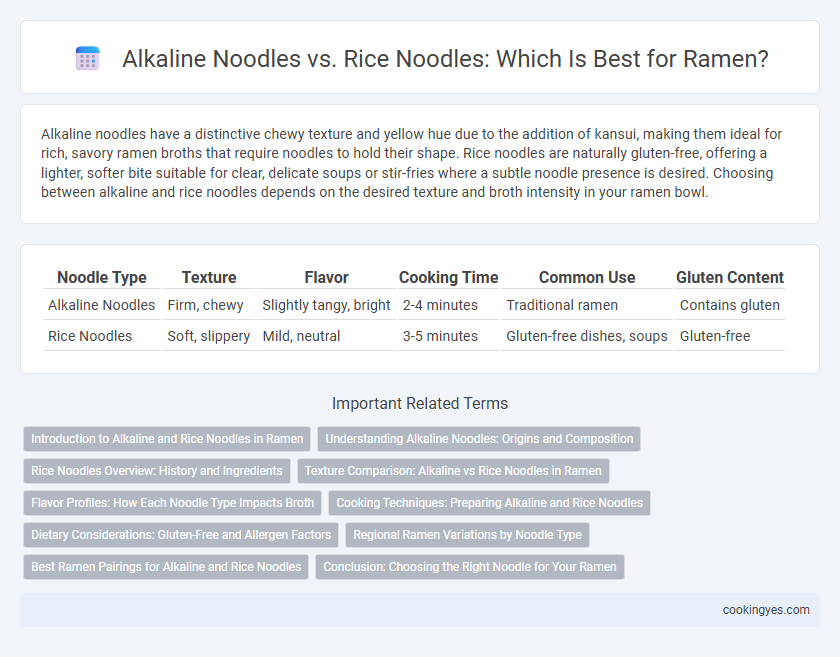Alkaline noodles have a distinctive chewy texture and yellow hue due to the addition of kansui, making them ideal for rich, savory ramen broths that require noodles to hold their shape. Rice noodles are naturally gluten-free, offering a lighter, softer bite suitable for clear, delicate soups or stir-fries where a subtle noodle presence is desired. Choosing between alkaline and rice noodles depends on the desired texture and broth intensity in your ramen bowl.
Table of Comparison
| Noodle Type | Texture | Flavor | Cooking Time | Common Use | Gluten Content |
|---|---|---|---|---|---|
| Alkaline Noodles | Firm, chewy | Slightly tangy, bright | 2-4 minutes | Traditional ramen | Contains gluten |
| Rice Noodles | Soft, slippery | Mild, neutral | 3-5 minutes | Gluten-free dishes, soups | Gluten-free |
Introduction to Alkaline and Rice Noodles in Ramen
Alkaline noodles, commonly used in traditional ramen, contain kansui, a mineral-rich alkaline water that gives the noodles their characteristic firm texture and yellow hue while enhancing flavor absorption. Rice noodles, often gluten-free, offer a lighter and chewier alternative, favored in gluten-sensitive diets, but lack the elasticity and bite of alkaline noodles crucial for authentic ramen. Understanding these noodle types highlights the textural and taste profiles essential to crafting diverse ramen experiences.
Understanding Alkaline Noodles: Origins and Composition
Alkaline noodles, traditionally used in ramen, are made by adding kansui, an alkaline mineral water containing sodium carbonate and potassium carbonate, which gives the noodles their distinctive yellow color and firm, chewy texture. Originating from Chinese wheat noodles, alkaline noodles enhance flavor and resilience during cooking compared to rice noodles, which are made from rice flour and possess a softer, more delicate texture. The alkaline pH in these noodles alters gluten structure, making them ideal for absorbing rich broth without becoming mushy, setting them apart in ramen cuisine.
Rice Noodles Overview: History and Ingredients
Rice noodles, originating from China over 2,000 years ago, are made primarily from rice flour and water, offering a delicate texture and subtle flavor ideal for light, broth-based dishes. Unlike alkaline noodles, which contain kansui to give a chewy and firm bite, rice noodles are naturally gluten-free and softer, making them popular in various Asian cuisines such as Vietnamese pho and Thai pad thai. Their simple ingredients and mild taste allow them to absorb flavors well, enhancing the overall dining experience in traditional and modern recipes alike.
Texture Comparison: Alkaline vs Rice Noodles in Ramen
Alkaline noodles in ramen offer a firm, chewy texture due to the addition of kansui, which enhances elasticity, making them ideal for holding rich broths. Rice noodles, in contrast, provide a softer, more delicate bite with a slightly slippery surface, resulting in a lighter mouthfeel that absorbs broth flavors differently. The distinct textures impact the overall ramen experience, with alkaline noodles delivering a more robust chew while rice noodles create a tender, smooth palate sensation.
Flavor Profiles: How Each Noodle Type Impacts Broth
Alkaline noodles enhance ramen broth by adding a slightly firm, chewy texture that absorbs flavors deeply, creating a rich and savory experience. Rice noodles contribute a lighter, subtler taste, allowing the broth's delicate nuances to shine without overwhelming the overall profile. Choosing alkaline noodles intensifies umami and saltiness, while rice noodles maintain a clean, refreshing palate balance.
Cooking Techniques: Preparing Alkaline and Rice Noodles
Alkaline noodles require boiling in rapidly boiling water for 2-3 minutes to achieve a firm and chewy texture, while rice noodles need soaking in hot water for 5-10 minutes until soft but not mushy. Alkaline noodles, rich in kansui (alkaline water), maintain their yellow color and springy bite even after cooking, making them ideal for ramen dishes. Rice noodles, made from rice flour, demand gentle handling during cooking and draining to avoid sticking and breaking, commonly used in soups and stir-fries.
Dietary Considerations: Gluten-Free and Allergen Factors
Alkaline noodles, commonly used in ramen, contain gluten, making them unsuitable for individuals with celiac disease or gluten sensitivity. Rice noodles provide a gluten-free alternative, ideal for those avoiding allergens related to wheat proteins. Choosing rice noodles supports dietary restrictions while maintaining a similar texture and taste profile in Asian cuisine.
Regional Ramen Variations by Noodle Type
Alkaline noodles, characterized by their firm texture and yellow hue due to added kansui, are a staple in traditional Japanese ramen varieties like Sapporo and Hakata, enhancing the broth's absorption and chewiness. In contrast, rice noodles are predominantly found in regional variations influenced by Southeast Asian cuisines, such as Okinawa's Satamen, offering a lighter, gluten-free alternative that complements clear or seafood-based broths. These distinct noodle types reflect regional preferences and local ingredient availability, shaping unique ramen experiences across Japan.
Best Ramen Pairings for Alkaline and Rice Noodles
Alkaline noodles, rich in kansui, provide a firm and chewy texture that perfectly complements rich, savory tonkotsu or shoyu ramen broths by absorbing robust flavors. Rice noodles, naturally gluten-free and delicate, pair best with lighter, clear broths like chicken or vegetable ramen, enhancing freshness without overpowering subtle tastes. Matching noodle texture and broth intensity is essential for an authentic and balanced ramen experience.
Conclusion: Choosing the Right Noodle for Your Ramen
Alkaline noodles, known for their firm texture and yellow hue, provide a chewy bite that holds up well in rich, savory ramen broths, enhancing the traditional ramen experience. Rice noodles, being gluten-free and softer, offer a lighter alternative that absorbs delicate flavors but may become soggy in heavier soups. Select alkaline noodles for authentic, hearty ramen or rice noodles for a gentle, gluten-free option that complements lighter broths.
Alkaline noodles vs Rice noodles for noodle type Infographic

 cookingyes.com
cookingyes.com